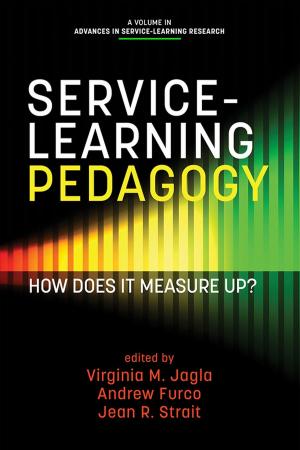High Stakes Accountability
Implications for Resources and Capacity
Nonfiction, Reference & Language, Education & Teaching, Higher Education, Administration| Author: | ISBN: | 9781607528760 | |
| Publisher: | Information Age Publishing | Publication: | January 1, 2009 |
| Imprint: | Information Age Publishing | Language: | English |
| Author: | |
| ISBN: | 9781607528760 |
| Publisher: | Information Age Publishing |
| Publication: | January 1, 2009 |
| Imprint: | Information Age Publishing |
| Language: | English |
In this third volume of Research in Education Fiscal Policy and Practice, editors Jennifer King Rice and Christopher Roellke have assembled a diversity of research studies focused on the current policy environment of high stakes accountability and how this context has impacted educators and students at multiple levels of the system. This effort to leverage student performance through high stakes reform has accelerated and intensified considerably since the 2002 reauthorization of the federal Elementary and Secondary Education Act, commonly referred to as No Child Left Behind (NCLB).In order for high stakes accountability reforms to realize their stated aims, targeted schools must have or acquire the resources and capacity to meet prescribed performance standards (Hess, 1999; Malen & Rice, 2005; Mintrop, 2003, 2004; Wong, et al., 1999), yet little systematic research has been assembled to document the implications of high stakes accountability systems on the resources and capacity of schools and school systems. This book aims to fill that gap. With this in mind, authors were asked to pay specific attention to challenges school systems confront as a result of NCLB and other high stakes reforms. The contributing authors were asked to think of policymakers and practitioners at local, state, and national levels as the intended audiences for their work. Our contributors responded with a collection of studies examining the relationship between high stakes reform and school district staffing, the recruitment and distribution of high quality teachers, curriculum making, and the provision of supplemental educational services to children. Our book is organized into three sections. The first provides a framework for assessing the impact of high stakes accountability policy on school capacity and also addresses implementation challenges at both state and local levels. The second section focuses on the impact of federal and state policymaking on teacher staffing and workplace conditions. The final section includes three chapters that provide a range of critiques on federal policymaking, including legal challenges to NCLB.
In this third volume of Research in Education Fiscal Policy and Practice, editors Jennifer King Rice and Christopher Roellke have assembled a diversity of research studies focused on the current policy environment of high stakes accountability and how this context has impacted educators and students at multiple levels of the system. This effort to leverage student performance through high stakes reform has accelerated and intensified considerably since the 2002 reauthorization of the federal Elementary and Secondary Education Act, commonly referred to as No Child Left Behind (NCLB).In order for high stakes accountability reforms to realize their stated aims, targeted schools must have or acquire the resources and capacity to meet prescribed performance standards (Hess, 1999; Malen & Rice, 2005; Mintrop, 2003, 2004; Wong, et al., 1999), yet little systematic research has been assembled to document the implications of high stakes accountability systems on the resources and capacity of schools and school systems. This book aims to fill that gap. With this in mind, authors were asked to pay specific attention to challenges school systems confront as a result of NCLB and other high stakes reforms. The contributing authors were asked to think of policymakers and practitioners at local, state, and national levels as the intended audiences for their work. Our contributors responded with a collection of studies examining the relationship between high stakes reform and school district staffing, the recruitment and distribution of high quality teachers, curriculum making, and the provision of supplemental educational services to children. Our book is organized into three sections. The first provides a framework for assessing the impact of high stakes accountability policy on school capacity and also addresses implementation challenges at both state and local levels. The second section focuses on the impact of federal and state policymaking on teacher staffing and workplace conditions. The final section includes three chapters that provide a range of critiques on federal policymaking, including legal challenges to NCLB.















